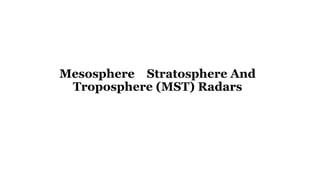Mesosphere stratosphere and troposphere (mst) radars
•Download as PPTX, PDF•
0 likes•217 views
MAT Radr
Report
Share
Report
Share

Recommended
Satellite communication - Dennis Roddy notes chapter 2satellite communication Notes_chapter 2

satellite communication Notes_chapter 2Valia koonambaikulathamma college of engineering and technology
Recommended
Satellite communication - Dennis Roddy notes chapter 2satellite communication Notes_chapter 2

satellite communication Notes_chapter 2Valia koonambaikulathamma college of engineering and technology
More Related Content
What's hot
What's hot (20)
Link Power Budget Calculation and Propagation Factors for Satellite COmmunica...

Link Power Budget Calculation and Propagation Factors for Satellite COmmunica...
Similar to Mesosphere stratosphere and troposphere (mst) radars
Propagation Effects and Their Impact on Satellite-Earth Links: Introduction,
Quantifying attenuation and depolarization,
Propagation effects that are not associated with hydrometeors, Prediction of rain attenuation,
Prediction of XPD,
Propagation impairments countermeasures.Propagation effects and their impact on satellite earth links

Propagation effects and their impact on satellite earth linksInternational Islamic University Chittagong
Similar to Mesosphere stratosphere and troposphere (mst) radars (20)
Radar is a detection system that uses radio waves to determine the range, ang...

Radar is a detection system that uses radio waves to determine the range, ang...
Propagation effects and their impact on satellite earth links

Propagation effects and their impact on satellite earth links
Recently uploaded
Recently uploaded (20)
Working Principle of Echo Sounder and Doppler Effect.pdf

Working Principle of Echo Sounder and Doppler Effect.pdf
Artificial intelligence presentation2-171219131633.pdf

Artificial intelligence presentation2-171219131633.pdf
Instruct Nirmaana 24-Smart and Lean Construction Through Technology.pdf

Instruct Nirmaana 24-Smart and Lean Construction Through Technology.pdf
Research Methodolgy & Intellectual Property Rights Series 1

Research Methodolgy & Intellectual Property Rights Series 1
Filters for Electromagnetic Compatibility Applications

Filters for Electromagnetic Compatibility Applications
Independent Solar-Powered Electric Vehicle Charging Station

Independent Solar-Powered Electric Vehicle Charging Station
Passive Air Cooling System and Solar Water Heater.ppt

Passive Air Cooling System and Solar Water Heater.ppt
Seismic Hazard Assessment Software in Python by Prof. Dr. Costas Sachpazis

Seismic Hazard Assessment Software in Python by Prof. Dr. Costas Sachpazis
5G and 6G refer to generations of mobile network technology, each representin...

5G and 6G refer to generations of mobile network technology, each representin...
NO1 Best Powerful Vashikaran Specialist Baba Vashikaran Specialist For Love V...

NO1 Best Powerful Vashikaran Specialist Baba Vashikaran Specialist For Love V...
Mesosphere stratosphere and troposphere (mst) radars
- 1. Mesosphere Stratosphere And Troposphere (MST) Radars
- 2. Introduction • For MST Radars M-Mesosphere,S-Stratospher and T-Tropsphere and is collectively termed as MST-Radars.These types of the Radars are able to give the atmospheric information from 10 KM To 100 KM. • These radars uses followsing technique for atmospheric measurements, 1.Doppler Beam Swinging (DBS) technique. 2.Spaced Antenna Drifts (SAD) technique. • These techniques uses following echoes for the measurements, a.Turbulent scatter b.Thermal or Incoherent Scatter c.Fresnel Scatter
- 4. Principles of MST Radar • MST Radar is used to investigate the motion of the middle atmosphere on all temporal and spatial scales and also to study the interactions among the three different regions of the atmosphere namely, Mesosphere, Stratosphere, Troposphere. • It is high power phase coherent pulse Doppler radar operating typically around 50 MHz with an average power-aperture product exceeding about 5x107 Wm2 . • It receives echoes due to the scattering and reflection from variation in radio refractive index of neutral atmosphere which in turn depends on variability of humidity, temperature and electron density induced by turbulence in the lower and middle atmosphere. It provides estimates of atmospheric winds on a continuous basis at high temporal and spatial resolutions required to study of various dynamical processes of the atmosphere. • MST radar uses the echoes obtained over the height range of 1-100 km to study winds, waves, turbulence and atmospheric stability.
- 5. Advantages of MST Radar • It can works for any atmospheric conditions. • Sophisticated antenna system gives better results.